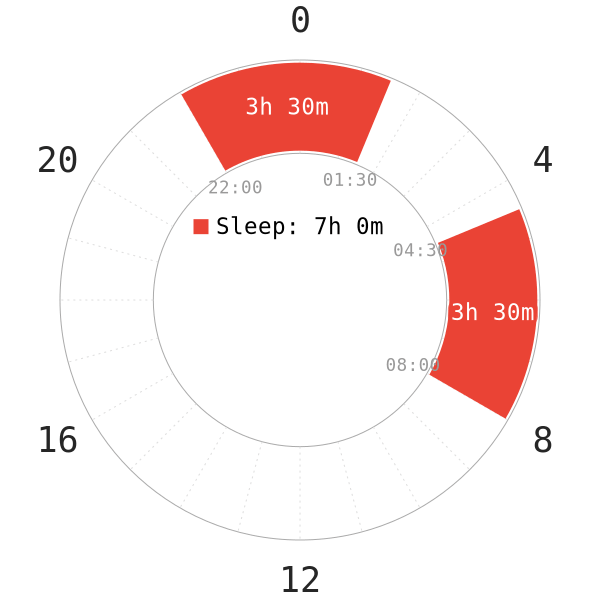
Segmented sleep is one of the oldest polyphasic patterns to date. It consists of 2 core sleeps with a wake period in between. Most sleep occupies the night and there are no daytime naps. Being popular even today, Segmented sleep has had many successful scheduling variations. With undeniable niches, Segmented sleep sets itself apart from the other 3 biphasic schedules.
Content
- History
- Mechanism
- Difficulty
- Alternate Variants
- Lifestyle Considerations
History
Segmented sleep, sometimes known as Bifurcated/Divided sleep, is one of the oldest polyphasic schedules. Aside from a progenitor of Dual Core sleep, its non-reducing creation was natural and dated back to the preindustrial era (1750-1850). This roughly adds to its impressive 250 years old as of today.
- In short photoperiods (less daytime hours and more night time hours), human sleep is also naturally segmented1. People would often go to bed after sunset and wake up after some hours at night. They then stay awake for a couple hours and then go back to bed until sunrise.
- Segmented sleep is still common nowadays, however. Many are still practicing this sleep habit whether voluntary in the world.
- There are also implications of Segmented sleep in the Bible2. This implies that dedicated prayers can rely on Segmented sleep to pray during the night gap.
- Certain tribes are also known for having a segmented sleep pattern at night.
In the modern era, natural Segmented sleepers often report to have a short wake gap between 2 cores (~1.5-3h). This is as a result of interrupted monophasic sleep in the middle of the night. It only makes sense that sleepers would wake up from the first core and do something at night for some time. They would return to bed if sleepiness level rises enough.
Currently, the Polyphasic Discord Community has discovered more sleep mechanics of Segmented sleep.
Mechanism
Sleep Distribution
- For starters, Segmented is one of the 5 polyphasic schedules with only core sleeps (2) and no naps.
- The sleep peaks are behind the ideation of Segmented sleep.
- The early hours of the night (~9-10 PM, SWS peak) are when natural melatonin secretion begins. Quality SWS will largely benefit from sleep time around these hours. Throughout a lot of EEG readings of adapted sleepers, it is commonly seen that the first core sleep is highly SWS-oriented.
- The late hours of the night (~5-8 AM, REM peak) comes the second core sleep. This core allows for densely populated REM sleep.
- However, some minor amount of REM sleep can still be present in the first core sleep, and the same for SWS in the second core. The usually high amount of total sleep explains this phenomenon well.
- The segmentation of the monophasic core into 2 cores around the sleep peaks bolsters sleep quality with much deeper core sleeps. This also enables some potential sleep reduction with strict bedtime everyday.
- Since 2 core sleeps already concentrate around night hours (similar to monophasic sleep), there is no need for daytime napping. The amount of light sleep from both cores is sufficient to sustain wakefulness for the entire day.
Wake Gap between Two Cores
- The wake gap between each core should be at least 90m, but usually even more (~2.5-3h) for non-natural Segmented sleepers to ease the adaptation.
- This to avoid interrupted monophasic sleep, where the wake period is too short to clearly define 2 separate sleep blocks. Staying awake for at least ~90m will separate the interruption and create an entirely new sleep architecture for the second core.
- Should the wake gap be too short, it will be unproductive to do different activities and it may be difficult to fall asleep in the second core; sleep pressure is not high enough to induce sleep. Some people have quit Segmented with a 2h gap because of the inability to adapt or feeling too unproductive during these short night gap.
Changes in Core Duration Scheduling
It may look odd that both core sleeps last for 3.5h rather than the usual 3h or 4.5h; however, over the years, each core consists of 2 full sleep cycles plus an extra 30 minutes of sleep time to cover the statistically likely REM period.
This is also similar to 5h and 6.5h cores. The statistically likely REM period originates from Polyphasic Society. However, there is poor evidence, with only 8 monophasic readings.
While its existence is questionable, it is still possible to see the effects from having 3.5h cores. Another explanation for the 30m extension on each core is the possibility that the cycles extend to roughly 105m; this is different from the standard 90m cycles in monophasic sleep. This would show the viability of the schedule despite having fewer cycles.
Adaptation Difficulty
Before attempting this schedule, it is important to look over all Biphasic patterns to choose if Segmented sleep is worth the choice.
- For naturally Segmented sleepers, the adaptation is basically complete if they already have a long exposure to the core-split mechanics.
- For non-natural Segmented sleepers, adapting to Segmented is potentially more challenging than to a biphasic pattern with a long, uninterrupted core sleep at night, such as Siesta and E1. It is still possible to adapt to Segmented; however, initially waking up from the first core can pose common issues (e.g, heavy sleep inertia, boredom during the night gap).
- The second core sleep can cause certain amounts of sleep inertia, grogginess or even slight dizziness upon waking up. This is due to the effects of the dense eye-movement activities from REM sleep. Over time, with enough consistency, these issues will no longer persist. Waking up will be invigorating from each sleep.
- Non-natural segmented sleepers can still experience certain glimpses of mild unproductivity during the night gap after adaptation. It may require an extended amount of time on the schedule to fully enjoy the night gap.
After Segmented adaptation, one can then proceed to a Dual Core schedule or any other multi-core schedules. This would logically follow the habit of having at least 2 core sleeps around night hours.
Alternate Variants
While the standard core combination has brought about a lot of successes in the community, multiple other core combinations are also viable and promising. With proper consideration, polyphasic beginners can attempt these variants with some precautions and recommendations at hand.
Slightly Shortened Core Sleeps
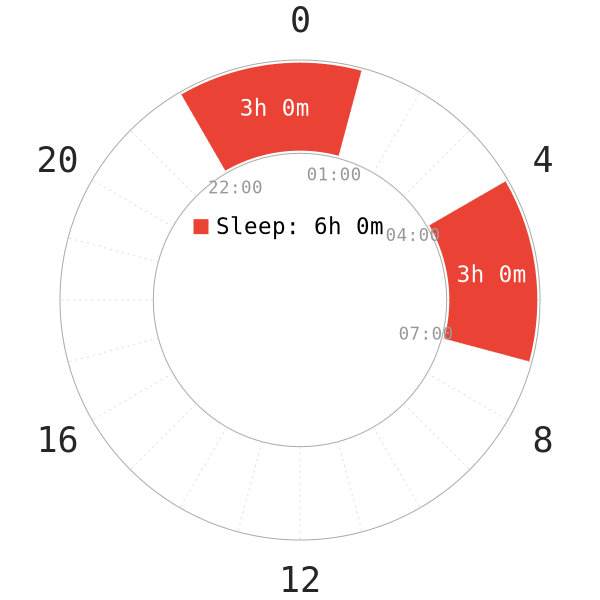
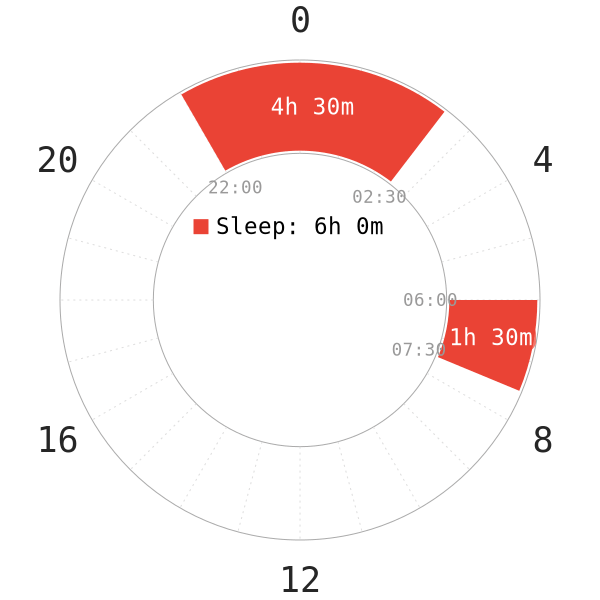
These are 2 possible modified variants that have reported some success. Since the total sleep is only 6 hours, it is better for people with slightly reduced monophasic duration/requirements (e.g, 7-7.5h). The danger when adapting to this schedule would be the tiredness periods around the circadian nadir (noon-early afternoon hours) while there are no naps. Because there is less light sleep than the 7h version, they likely have a poorer wakefulness sustenance through a day.
The wake gap between each core can be at least 3h to cover more hours of each sleep peak. The overall adaptation may be more difficult than on the standard version for average sleepers because of the reduced sleep time. The benefits are hefty:
- The added extra wake time (1 more hour)
- Having to sleep only twice per day
- No need any daytime naps
If adaptation is possible, these variants would be one of the best ways to enjoy Segmented sleep.
The differences between 4.5-1.5 and 3-3 core distribution are as follows:
- Those with more SWS requirements (e.g, intense training or just naturally higher than usual) can attempt the former option.
- Those with more REM sleep and a reasonable amount of SWS requirements can pick the latter.
- Overall, the 3-3 variant gives a better balance for each sleep stage; it also has some slight advantage in adaptation success.
Uneven Core Durations
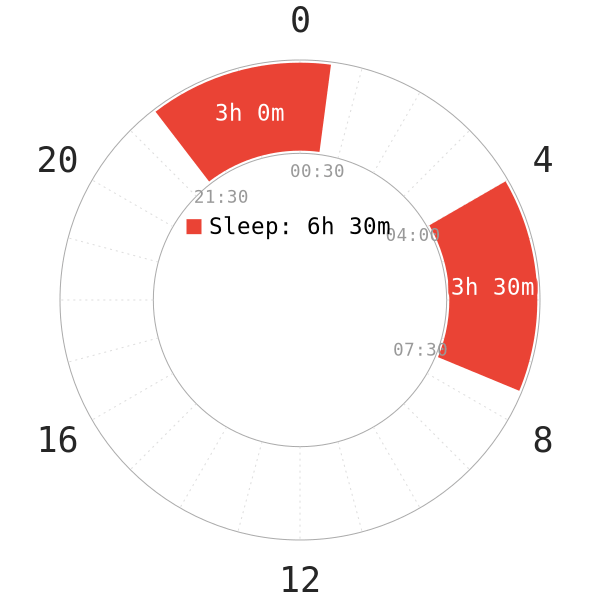
This is one of the many variants whose core durations are not equal to each other. Excluding the 4.5-1.5 variant from the previous section, here either core can be slightly longer or shorter than the other. Total sleep still hovers around ~6.5-7h. These variants serve to:
- Salvage a bit more extra wake time than the original version
- Essentially not increasing the adaptation difficulty much.
There is very rare success with these types of scheduling, however. Other viable combinations include 3.5-3, or even 4.5-2.5 and 5-1.5. It would be helpful to know the SWS and REM requirements before picking any of these variants, though.
Below are the characteristics of these variants:
- Variants with a longer first core can help with sustaining alertness better through the graveyard hours between 2 cores, and the second core does not need to be as long.
- The longer the first core, the less distinct its sleep architecture will become. What this means is that a longer first core (e.g, 4.5-5h core) will no longer contain mostly SWS. It will have a decent amount of REM sleep and become a mixed core.
- The longer first core also gives the impression of Siesta sleep, with the second sleep looking like a daytime core sleep.
Late First Core
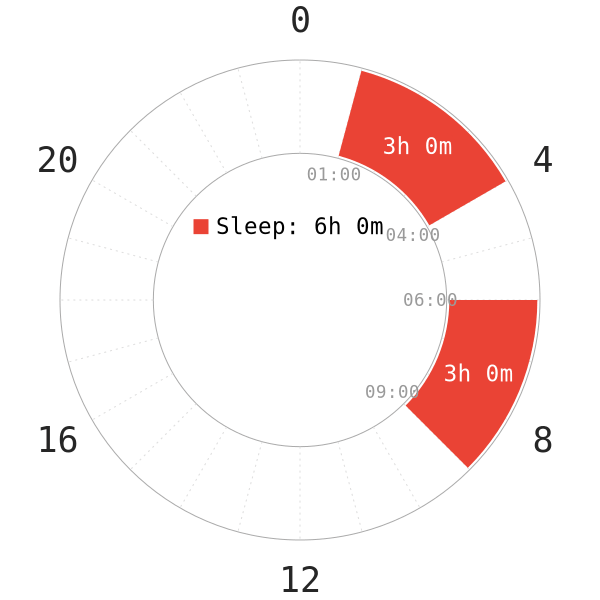
Even though it seems unrealistic and even impossible to schedule this variant, over the years there has been a success or two. Sleepers who would schedule this variant should have low SWS needs, and/or a lot of polyphasic experience. They would also have the stringent management of food, exercise and lighting.
Since the first core is out of the SWS peak entirely, it is necessary to employ various methods to ensure a sufficient amount of SWS, especially when coupled with heavy exercising. Similar to the previous options, multiple core combinations can apply in this scheduling scheme. There are, however, a lot of hefty benefits from this type of variant:
- Social time in the evening is secure, because sleep time is not as early as the standard version.
- The wake gap between 2 cores can be smaller than the original version; this is because of a potentially higher SWS pressure that will be resolved in the second core sleep.
- Those with a second shift work schedule. These individuals would often go home in late evening hours while not having to work in the morning.
- A somewhat short sleeper would even benefit from this variant more. Their core combination can be 3-2, or 3.5-1.5, etc. Not only is there more extra wake time, but all the access to evening events like other monophasic individuals. They can also enjoy an uninterrupted flow of daytime commitments without needing any naps.
All in all, adaptation to this variant is expected to be very difficult, which is something to note.
Segmented-shortened
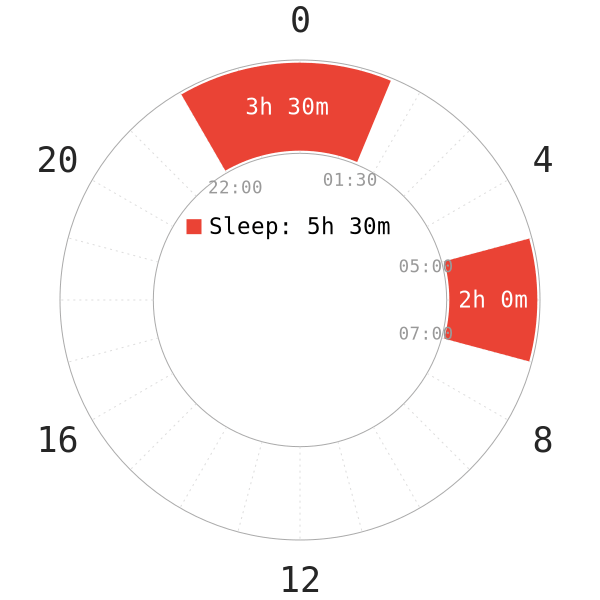
Like other drastically reduced schedules, Segmented-shortened only fit sleepers with reduced sleep requirements. So far, short sleepers in the community (~6h monophasic or less) have been able to adapt to this very difficult Segmented variant.
A couple things to note about scheduling shortened versions:
- Because short sleepers often have a normal amount of SWS while less REM duration, the second core is often shorter.
- To qualify as “shortened”, either core sleep should reduce at least 90m from the base schedule. For example, a 2h core or 90m core rather than the default ~3 or 3.5h cores.
- Up to date, the bulk of success comes from a usually longer first core, approximately at least ~3h. In addition, these short sleepers often enjoy the short second core.
- Because of the short sleep gene advantage, they are capable of starting the first core later than usual. For example, 11 PM or midnight rather than a usually earlier time.
- Alternative core duration combinations include:
- Both 2.5h cores
- 3h-2.5h cores
- 3h-1.5h cores
- 3.5h-1.5h cores
Segmented-extended/Non-reducing
Either variants so far only report some success over the years.
Extended
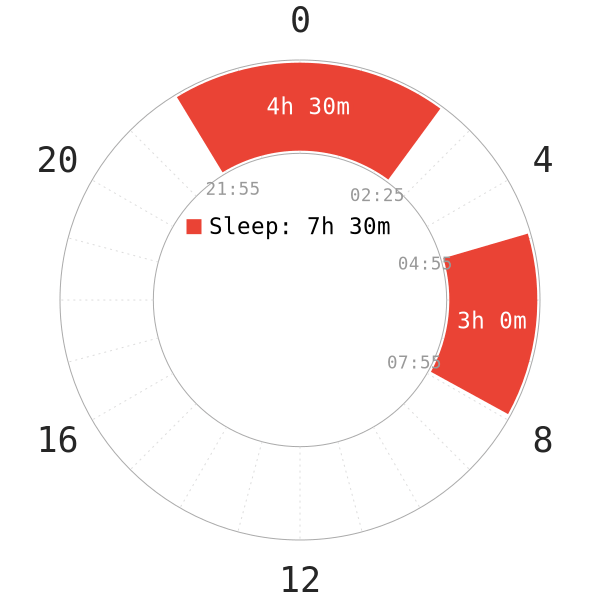
The extended version (7.5-8h sleep) can still contribute to some amount of sleep reduction (e.g, 9h monophasic sleeper). These sleepers can still enjoy some extra wake time even with some sleep extension.
The downside is that the extended version likely limits more wake time during evening hours. However, this version can also become quite flexible after adaptation as well.
Non-reducing
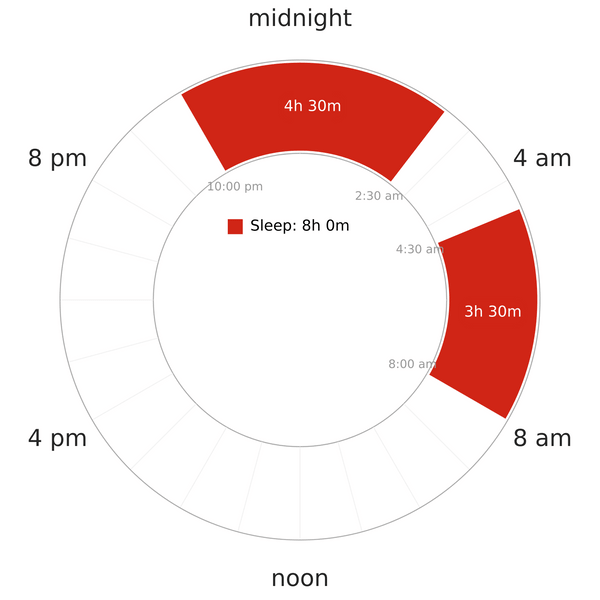
- Does not reduce any sleep (e.g, 4.5-4.5 core combo for 9h sleeper).
- Has achieved a lot of success since the preindustrial era; this brings up the point that segmented sleep can be a natural sleep pattern for humans. Nowadays, with the advent of blue light and certain difficulties against social time around evening hours, it is a lot harder to adapt to.
- Potentially can allow for some flexibility of either core during adaptation.
- Naturally segmented sleepers can still adapt if they habitually wake up during the night and simply go to bed when they are tired enough.
Another downside of both variants is that the longer core sleeps plus the wake gap between 2 cores makes the second core end later than usual. This can then clash with morning commitments if one has to wake up earlier than usual.
One success from the non-reducing variant (~7h total sleep on average) has the first core being ~4.5h long consistently (3 full cycles) and the second core hovers around 2h on average (~1.5-2.5h depending on day).
This suggests that short sleepers can utilize non-reducing variants to achieve a very flexible Segmented scheduling to great effects. For non-natural Segmented sleepers, it is still advisable to try to sleep at the same time everyday for each core sleep.
Regardless, not reducing total sleep may make it more difficult to adapt, because of the overall lower sleep pressure than a reducing variant.
Siesta-hybrid
Late “siesta”
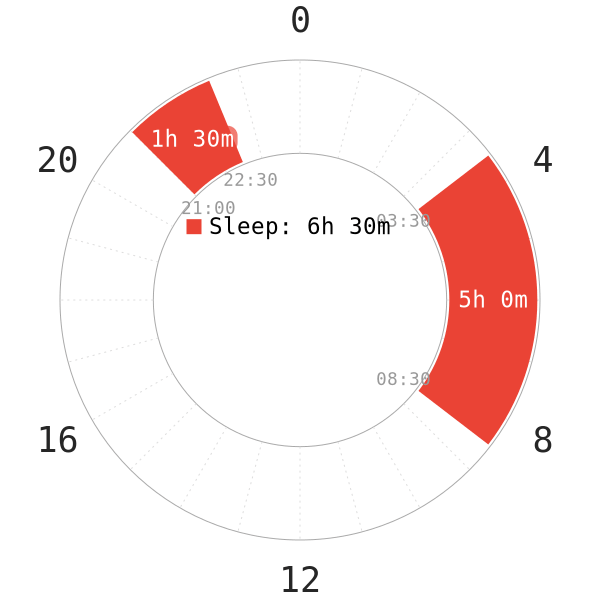
This variant has surprisingly recorded at least 2 successes over time up to date; one attempt was in a winter, when photoperiod was short. The first core becomes a lot shorter than usual, reducing all the way to only 1 cycle; meanwhile, the second core is dramatically long to compensate for the first core. Similar ideas can apply to 2.5-4.5 core distribution or so.
The idea behind this variant is to have a very long wake gap between each core; the second core can still occupy a fair amount of REM peak hours and provide sufficient SWS. The main concerns are as follows:
- Since it is impossible for an average sleeper with at least 90m SWS to meet all SWS in the first core; the second core will have to provide the remaining SWS.
- Pushing the second core to very late hours at night may increase the difficulty of the process. Thus, sleepers with lower SWS requirements or want to sleep less around evening hours can attempt this variant.
- This variant also takes away most, if not all social time in the evening; social time will have to be in exchange with the long wake gap between cores.
However, with a very unorthodox scheduling and the excessively long dark period, it will be extremely difficult to make this Segmented variant work.
No peaks
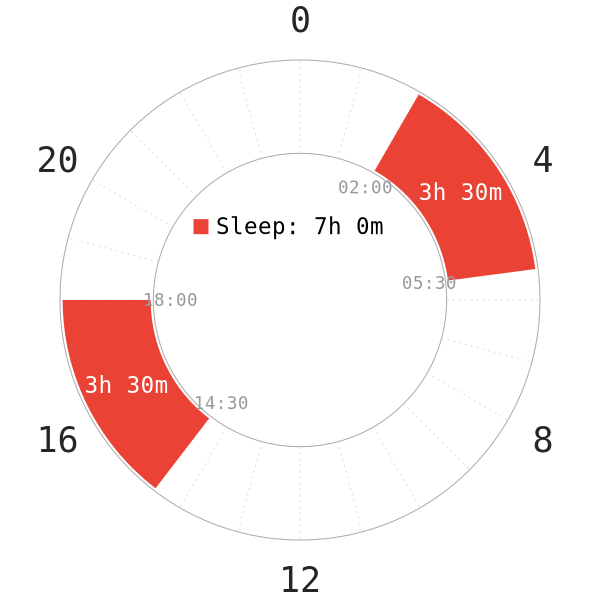
- This variant looks like Siesta with a long daytime core, and both core sleeps miss out on the peaks.
- The dark period should be 2-3h before the night core, and continue for ~2h after this core to stabilize the circadian rhythm.
- Over the course of adaptation, staying awake during the graveyard and morning hours will be tough.
- Having a long sleep in the day immediately can shake up the current sleep habits. This is the case if sleepers or non-nappers have been used to the regular 7-8h monophasic exclusively at night.
- The personal sleep peaks may change with artificial melatonin onset as a result of these new Segmented habits; however, this entrainment will likely require an extended period of time for the circadian rhythm to fully rotate to the new sleep habits.
Adaptations are rare and a lot more difficult than a regular Segmented schedule. Skipping both sleep peaks can greatly hinder quality sleep.
Third Shift
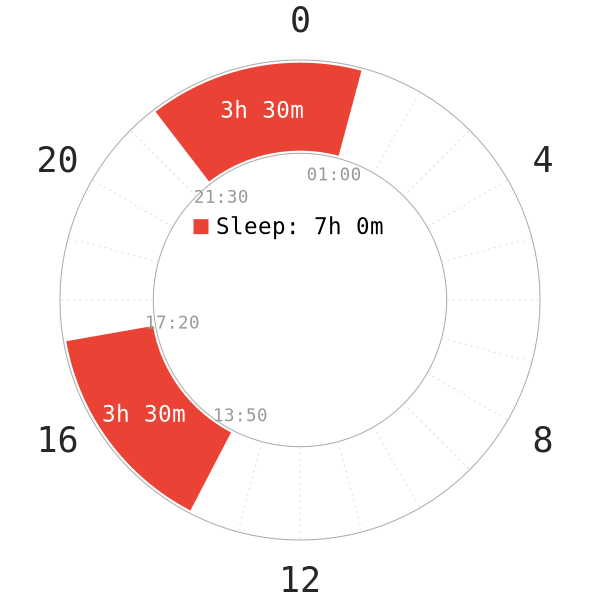
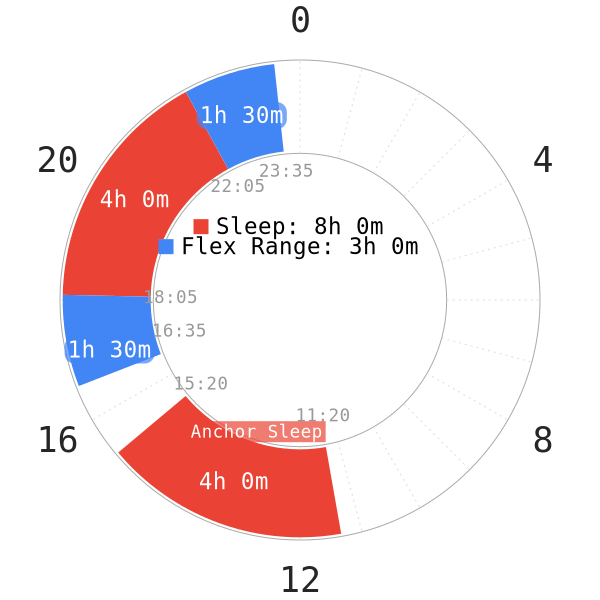
Very little is known about this scheduling method, and adaptations have been overall not rewarding. The nature of third shift often brings about changes in many health aspects.
This includes, but not limited to, higher risks for cardiovascular diseases, increased stress, lowered immune system and hypertension in the long run. These ill effects are bound to show up even on a monophasic pattern.
Adapting to a Segmented pattern without the natural habit will result in a very risky adaptation. There have been at least a couple failures while deploying Segmented sleep for shift work; however, success is very rare, only a case or two. The idea is to have a core sleep right after the work period, and a core sleep before work. The plan on paper sounds compelling, but the adaptation process is far from easy.
Anchor sleep mechanic
Claudio Stampi had a detailed summary on the potential use of anchor sleep during shift work2. This in return can facilitate a polyphasic sleep behavior. The premise behind an anchored sleep is to keep at least 4h of continuous sleep at the same time every day of the week, regardless of work or off days.
This setup will prevent the desynchronization of the circadian rhythm. For example, a worker with a shift work schedule of midnight to 8 AM for 5 days a week can schedule Segmented sleep as follows:
- The first core will start some time after work (e.g, 9 AM to 1:30 PM). This 4.5h core will always be at these hours even on weekends.
- The second core can be flexible, at least ~2-3h after the first core, or around late afternoon hours. The closer it is to work hours, the longer wakefulness will last during work hours. This can help boost performance at work immensely.
- The flexible second core can give some wake hours during the day for social interactions.
- If the total sleep is non-reducing, then one can have a flexible Segmented schedule from the beginning. However, aside from the mandatory fixed core, the second core should not be any more flexible than ~1-1.5h in either directions.
Although the anchored sleep method is viable short-term according to Stampi, it unfortunately has very few data samples in the community. Thus, one should be very cautious when having a third shift. The adaptation difficulty of Segmented under this condition (regardless of sleep reduction) will also be much harder than under normal nocturnal sleep.
Lifestyle Considerations
Nocturnal sleep disruption
Given the extremely versatile ways of scheduling Segmented, there is a reason that Segmented sleep remains popular nowadays. In addition, many polyphasic sleepers have adapted to it, from the most basic beginners to the most experienced veterans.
A lot of brand new polyphasic sleepers often reflect on their inability to sleep in one chunk on monophasic sleep; they even perpetually wake up in the middle of the night. The perfect solution would then be to start a Segmented adaptation as a result of the abrupt awakening. Thus, Segmented sleep would greatly benefit these groups of population.
Research
There are lots of research on Segmented sleep. Check them out here.
Night Gap Planning
Before one transitions to Segmented, it is very important to plan ahead what to do during the wake gap between 2 cores. This is a critical component that can sway the adaptation to one’s favor. This is only if they know how to utilize the waking hours here.
Having nothing interesting to do can quickly become a daunting task to stay awake for many hours straight.
For non-segmented sleepers, there are a few tips to optimize these hours:
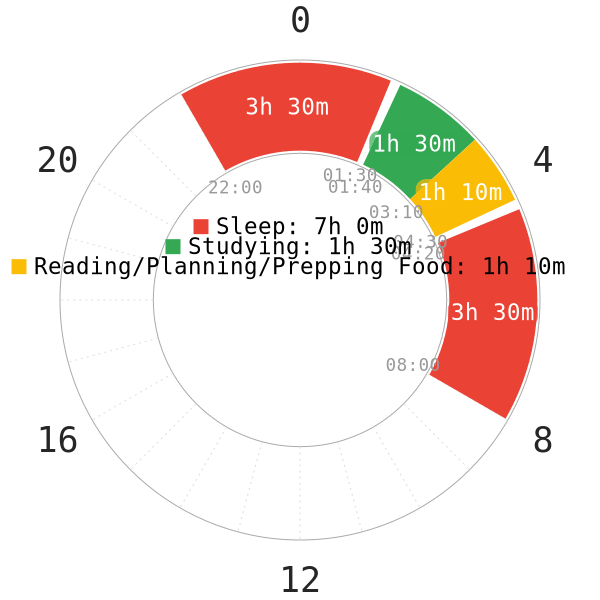
- Make a list of what activities or tasks that can be completed at night time.
- This includes entertainment activities (e.g, watching TV shows), studying (after the first core) to revise the learned materials prior to the first core.
- Entertainment is fair game if you have not had a chance to enjoy them properly for a while. Being alone can also keep disrupting social interruptions at bay.
- Dedicate to self-care. It is always a good thing to look after yourself after working in the day.
- Self-care is also great to relieve stress and anxiety. Autogenic training, meditation, yoga and stretching all come to mind.
- Just a brief session of 30-45m will help.
- Self-care is not something exclusive to Dual Core sleep, though.
- Plan your next day or day(s).
- Planning activities is often the activity that takes the most amount of time if you fully craft out what you have to do. In the roles of CEOs, managers and probably even interns and students, you will have a lot to work on and be concerned about.
- With clear planning comes clear execution of tasks. Thus, if you think hard enough, you should not run out of things to do.
Other Benefits of Segmented
In addition, there are massive advantages of Segmented that set it apart from other biphasic schedules.
Daytime Napping
- There is no need for a nap during the day.
- This effectively enthrones Segmented as the only schedule that can support more than 12h continuously staying awake without needing to nap. In modern society, this is an insurmountable perk that other polyphasic schedules cannot match.
- The seemingly endless wake gap allows for planning of several social events, even activisms, or any mainstream jobs that do not allow for any naps. This is a fantastic way to adapt to Segmented sleep and enjoy the long daytime wake gap just like any monophasic sleepers.
Later First Core
- Because of the high total sleep, it is very viable to schedule the first core at ~11-11:30 PM.
- The dark period may begin at approximately 9-10 PM if 2h dark period is not possible before the first core. This would allow one to schedule a bit more evening events without having to sleep too early.
- However, the late first core likely will delay the start time of the second core; thus, it is important to look at the second core and see if it will interfere with indispensable morning commitments.
Under normal scheduling, however, there will be more limited evening social time on Segmented sleep.
Flexibility
- Segmented sleep can become flexible after adaptation. However, the flexibility records of Segmented is more humble than those of E1.
- Certain experienced sleepers or sleepers who go through a moderately challenging/easy adaptation to Segmented have shown their ability to flex at least one core sleep.
- Being able to flex the core sleeps enables the freedom in controlling the amount of waking hours between each core depending on days.
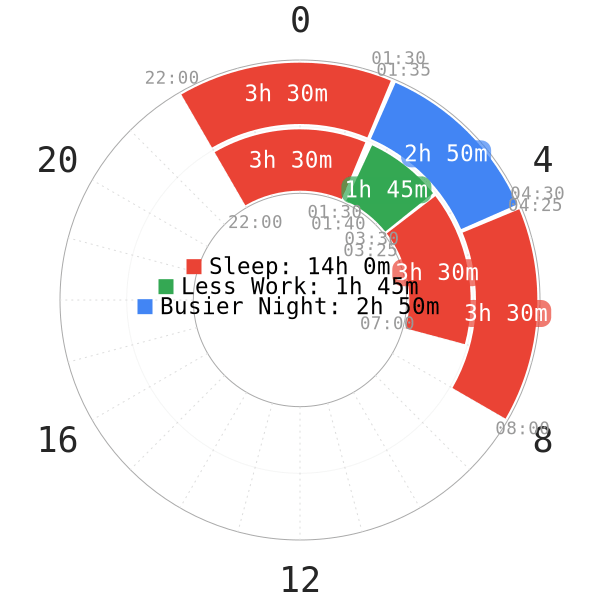
- For example, on certain days with nothing much to do, the core gap can shrink down a bit, so that the second core can start earlier than usual.
- If there are more obligatory tasks that need completion during this wake gap, one can delay the second core a bit; they can also start the first core earlier than usual.
- The resilience of Segmented sleep also allows it to absorb some damages in scheduling, such as a party night. One can delay the first core to after the party and start the second core some time after that. After adaptation, it should not take long to recover from such abrupt changes, as long as these do not happen too often.
Exercising
- Segmented sleep can support a lot of physical exercises; although like other schedules, it can be burdensome to keep the intense exercising habits while adapting.
- A longer first core and a shorter second core can remedy this issue. The purpose is to increase the mobility of SWS gain in the first core.
- After the adaptation is complete, exercise intensity can increase again to match the previous level.
Other Utilities
- The second core sleep on Segmented is often safe from real life interruptions.
- The second core is also often considered a REM stock for lucid dreaming. A lot of Segmented sleepers have reported a lot of vivid dreaming experiences in this core over the years.
- As an added bonus, the second core (often long enough) can fix some inconsistencies or hiccups in sleep quality from the first core (e.g, minor sleep interruptions, higher sleep onset than usual).
Despite the powerful advantages, Segmented seems at a disadvantage compared to other biphasic schedules; this is mostly for underage individuals, mostly those who are not natural Segmented sleepers.
These individuals are better off with a long, continuous core sleep at night rather than segmented core sleeps. This is a possible reason for quite a few incomplete adaptations.
Main author: GeneralNguyen
Page last updated: 8 April 2021
Reference
- WEHR, T. A. (1992). In short photoperiods, human sleep is biphasic. Journal of Sleep Research, 1(2), 103–107. doi:10.1111/j.1365-2869.1992.tb00019.x
- Holladay, William L. “Indications of segmented sleep in the bible.” The Catholic Biblical Quarterly 69.2 (2007): 215-221.
- Stampi, Claudio. Why We Nap : Evolution, Chronobiology, and Functions of Polyphasic and Ultrashort Sleep. Birkhauser, 2014.
